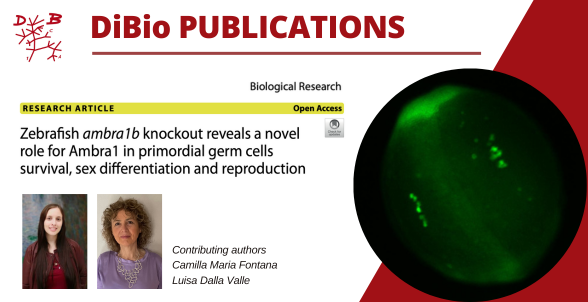
New Publication - Zebrafish ambra1b knockout reveals a novel role for Ambra1 in primordial germ cells survival, sex differentiation and reproduction
Pubblicato il: 02.05.2023 08:30
Zebrafish ambra1b knockout reveals a novel role for Ambra1 in primordial germ cells survival, sex differentiation and reproduction
AMBRA1, initially identified as a positive regulator of the Beclin1-dependent autophagic pathway, is an intrinsically disordered protein working as a scaffold-molecule to coordinate many cellular processes, such as autophagy, apoptosis, cell proliferation and development. The zebrafish genome contains two ambra1 paralogous genes, but only ambra1b homozygous mutants develop exclusively as males following the achievement of sexual maturity.
In the work published in “Biological Research” (https://doi.org/10.1186/s40659-023-00430-9), the authors focused their attention on the possible role of Ambra1b on zebrafish sex determination and found that the all-male phenotype of ambra1b mutants relies on a reduction of the primordial germ cells (PGCs) number during early developmental stages.
The research was coordinated by Camilla Maria Fontana (PhD at DiBIO UNIPD, now post-doc at the Chiang Mai University, Thailand) and Luisa Dalla Valle (DiBio UNIPD), and collaborators of UNIPD (Paolo Bonaldo and Ranieri Verin), UNICATT (Francesco Cecconi) and UNIVPM (Oliana Carnevali).
Remarkably, the PGC loss could be rescued with human AMBRA1 (hAMBRA1) mRNAs unmutated and mutated in different binding domains, but not with the hAMBRA1 mRNA mutated in the CUL4-DDB1 complex binding domain, suggesting a possible interaction with this complex in regulating PGC development, likely through regulation of Stat3 expression. Moreover, in agreement with the high expression of both ambra1 paralogs in the zebrafish testis and ovary, the authors found a significant impairment of the reproductive capabilities and the occurrence of pathological alterations, including tumors, mainly limited to the gonads. These findings, along with the increase in atretic follicles and the reduction of the antral ones in Ambra1+/− mice, unveil a new role of Ambra1 in reproductive physiology.





